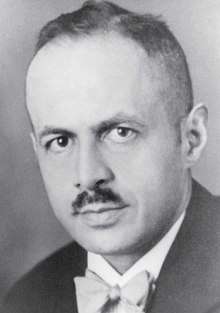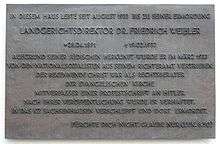Friedrich Weißler
Friedrich Weißler (born 28 April 1891 in Königshütte, Upper Silesia; died 19 February 1937 at Sachsenhausen concentration camp) was a German lawyer and judge. He came from a Jewish family but was baptized as Protestant as a child.[1] He belonged to the Christian resistance against National Socialism.

Biography
In March 1933, Weißler was dismissed as judge due to his opposition to the Nazis. He moved to Berlin and collaborated with the Protestant opposition (Confessing Church) within the Evangelical Church of the old-Prussian Union. From November 1934 on, he helped - as a legal advisor for the opposition - to cover the old-Prussian state bishop Ludwig Müller and his willing subordinates with a wave of litigations in the ordinary courts in order to reach verdicts on his arbitrary measures violating the church constitution (Kirchenordnung).[2] Since Müller usually acted without legal basis the courts often proved the litigants to be right.[3]
Weißler had already worked as legal advisor for the first preliminary church executive, the rivalling executive body, organised by the Confessing Church for the else Nazi-submissive German Evangelical Church. He was also appointed as legal advisor to the second preliminary church executive and further became its office manager.[4]
At Pentecost 1936 (31 May), the second preliminary church executive prepared a "memorandum" ("Denkschrift") to Hitler, also to be read from the pulpits (on 23 August 1936), condemning anti-Semitism, Nazi concentration camps and state terrorism. The memorandum was delivered to Hitler at the Chancelry on 4 June 1936, but there was no reaction from the government.[5] A draft was then leaked to and published in the foreign press in July 1936, during the build-up to the Olympic Games.[6]
If blood, race, nationhood and honour are given the rank of eternal values, so the Evangelical Christian is compelled by the First Commandment, to oppose that judgement. If the Aryan human is glorified, so it is God's word, which testifies the sinfulness of all human beings. If - in the scope of the National Socialist weltanschauung - an anti-Semitism, obliging to hatred of the Jews, is imposed on the individual Christian, so for him the Christian virtue of charity is standing against that.[7]
The memorandum concluded that the Nazi regime would definitely lead the German people into disaster.[8]

On 7 October 1936, the Gestapo arrested Weißler, erroneously blaming him for passing the memorandum into the hands of foreign media.[4] Weißler and two Aryan assistants who also worked for Confessing Church were arrested. Whereas the aryans were ultimately released, the church did not intervene for Weißler.[9] He was not taken to court, where the evidentially false blaming would have been easily unveiled, but deported to Sachsenhausen concentration camp and tortured to death from 13 to 19 February 1937[10] becoming the first, "full Jew", lethal victim of the Kirchenkampf on the Protestant side.[11]
Notes
- https://contemporarychurchhistory.org/2012/06/memorial-speech-friedrich-weissler-1891-1937-and-the-confessing-church-remembrance-and-commemoration-of-the-75th-anniversary-of-the-death-of-friedrich-weissler-sachsenhausen-memorial-and-museum/
- Ralf Lange and Peter Noss, "Bekennende Kirche in Berlin", in: Kirchenkampf in Berlin 1932-1945: 42 Stadtgeschichten, Olaf Kühl-Freudenstein, Peter Noss, and Claus Wagener (eds.), Berlin: Institut Kirche und Judentum, 1999, (Studien zu Kirche und Judentum; vol. 18), pp. 114-147, here p. 131. ISBN 3-923095-61-9.
- Barbara Krüger and Peter Noss, "Die Strukturen in der Evangelischen Kirche 1933-1945", in: Kirchenkampf in Berlin 1932-1945: 42 Stadtgeschichten, Olaf Kühl-Freudenstein, Peter Noss, and Claus Wagener (eds.), Berlin: Institut Kirche und Judentum, 1999, (Studien zu Kirche und Judentum; vol. 18), pp. 149-171, here p. 159. ISBN 3-923095-61-9.
- Martin Greschat, "Friedrich Weißler: Ein Jurist der Bekennenden Kirche im Widerstand gegen Hitler", In: Die verlassenen Kinder der Kirche: Der Umgang mit Christen jüdischer Herkunft im »Dritten Reich«, Ursula Büttner and Martin Greschat (eds.), Göttingen: Vandenhoeck & Ruprecht, 1998, pp. 86-122, here p. 115. ISBN 3-525-01620-4.
- "Werner Koch". Internationale Bonhoeffer-Gesellschaft (ibg), Deutschsprachige Sektion, e.V., Wolfhagen. Retrieved 3 September 2018.
- Matthew D. Hockenos (June 2016). "On the Confessing Church's June 1936 Memorandum to Hitler". Contemporary Church History Quarterly. Ambrose University, Calgary. Retrieved 2 September 2018.
- The German original: »Wenn Blut, Rasse, Volkstum und Ehre den Rang von Ewigkeitswerten erhalten, so wird der evangelische Christ durch das erste Gebot [Es lautet: »Du sollst keine anderen Götter neben mir haben.«] gezwungen, diese Bewertung abzulehnen. Wenn der arische Mensch verherrlicht wird, so bezeugt Gottes Wort die Sündhaftigkeit aller Menschen. Wenn dem Christen im Rahmen der nationalsozialistischen Weltanschauung ein Antisemitismus aufgedrängt wird, der zum Judenhaß verpflichtet, so steht für ihn dagegen das christliche Gebot der Nächstenliebe.« Cf. Martin Greschat (ed. and commentator), Zwischen Widerspruch und Widerstand: Texte zur Denkschrift der Bekennenden Kirche an Hitler (1936), Munich: Kaiser, 1987, (Studienbücher zur kirchlichen Zeitgeschichte; vol. 6), pp. 113seq. ISBN 3-459-01708-2.
- Klaus Drobisch, "Humanitäre Hilfe – gewichtiger Teil des Widerstandes von Christen (anläßlich des 100. Geburtstages von Propst Heinrich Grüber)", in: Heinrich Grüber und die Folgen: Beiträge des Symposiums am 25. Juni 1991 in der Jesus-Kirche zu Berlin-Kaulsdorf, Eva Voßberg (ed.), Berlin: Bezirkschronik Berlin-Hellersdorf, 1992, (Hellersdorfer Heimathefte; No. 1), pp. 26-29, here p. 28. No ISBN.
- Friedlander, Saul (1998). Nazi Germany and the Jews,1933-1945: Abridged Edition, New York: Harper Perennial, pp. 61-86
- Bethge, Renate; Gremmels, Christian (2006). Dietrich Bonhoeffer: A Life in Pictures. Fortress Press. p. 101. ISBN 978-0-8006-3811-5.
- The first lethal victim was the Catholic Erich Klausener, murdered on 30 June 1934. Paul Schneider (pastor) is referred to as the first cleric of the Evangelical Church of the old-Prussian Union, to have been murdered in the Kirchenkampf.